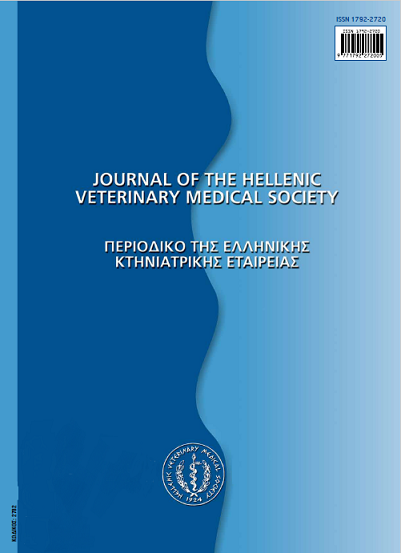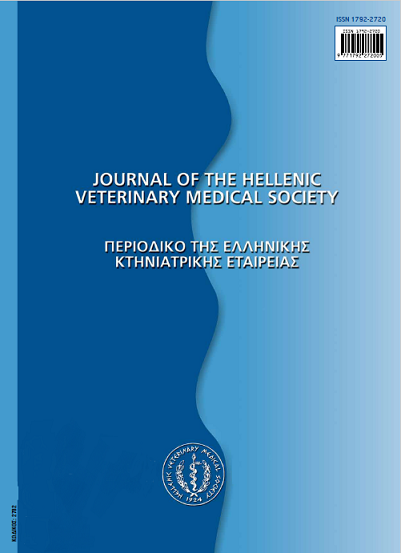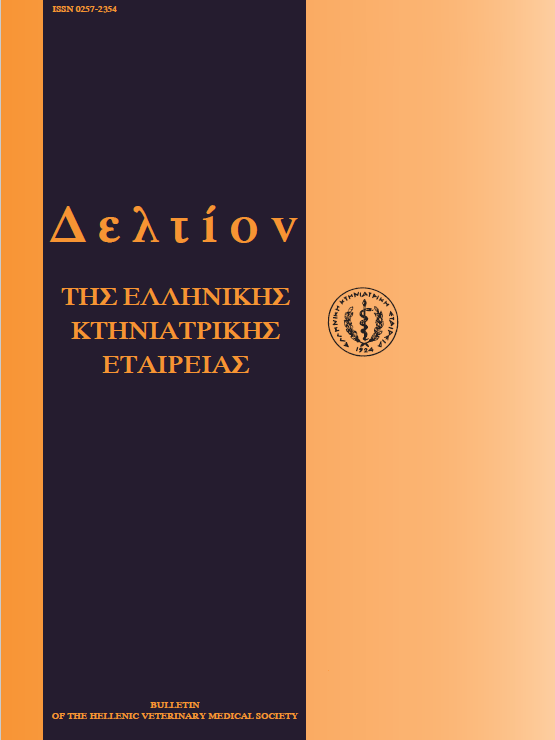Παρουσία του ζυμομύκητα Malassezia pachydermatis στον έξω ακουστικό πόρο ασθενών και κλινικώς υγιών σκύλων

Περίληψη
Διερευνήθηκε η παρουσία του ζυμομύκητα Malassezia pachydermatis στο ωτικό έκκριμα σκύλων με συμπτώματα έξω ωτίτιδας καθώς και κλινικώς υγιών. Δοκιμάστηκε επίσης η ευαισθησία του μικροοργανισμού σε αντιμυκητιακές ουσίες.Εξετάστηκαν 180 σκύλοι, 98 με συμπτώματα έξω ωτίτιδας και 82 κλινικώς υγιείς, στην περιοχή της Θεσσαλονίκης κατά την περίοδο1998-2000. Από τα δείγματα ωτικου εκκρίματος γινόταν απευθείας μικροσκοπική εξέταση και ενοφθαλμισμός σε ειδικά γιατην απομόνωση μυκήτων και βακτηρίων υποστρώματα. Από τα 90 στελέχη Μ. pachydermatis που απομονώθηκαν και ταυτοποιήθηκαν, 68 (69,38%) προέρχονταν από ζώα με ωτίτιδα και 32 (39,02%) από κλινικώς υγιή ζώα. Από 20 (20,39%) μολυσμένα και από 12 (14,63%) κλινικώς υγιή ζώα ο Μ. pachydermatis ήταν ο μόνος μικροοργανισμός που απομονώθηκε. Σε 48 περιπτώσεις ζώων με συμπτώματα ωτίτιδας και σε 20 κλινικώς υγιών,ο Μ. pachydermatis συνυπήρχε με διάφορα βακτήρια, όπως είδη του γένους Staphylococcus, Pseudomonas, Proteus και Streptococcus και με μύκητες του γένους Candida και Aspergillus. Ο S.intermedius απομονώθηκε από 13 περιπτώσεις μολυσμένων και 20 κλινικώς υγιών ζώων. Από 6 μολυσμένα και 22 κλινικώς υγιή ζώα απομονώθηκαν μόνο βακτήρια, ενώ από 11 μολυσμένα και 8 υγιή δεν απομονώθηκε κανένας μικροοργανισμός. Σε 46 στελέχητου Μ. pachydermatis έγινε δοκιμή ευαισθησίας σε 5 αντιμυκητιακές ουσίες. Το σύνολο των στελεχών βρέθηκε ευαίσθητο και στις τέσσερις ιμιδαζόλες, ενώ στη νυστατίνη 38 στελέχη ήταν ευαίσθητα και 8 ανθεκτικά.
Λεπτομέρειες άρθρου
- Πώς να δημιουργήσετε Αναφορές
-
BOURTZI-HATZOPOULOU (Ε. ΜΠΟΥΡΤΖΗ-ΧΑΤΖΟΠΟΥΛΟΥ) E., PETRIDOU (Ε. ΠΕΤΡΙΔΟΥ) E., & PSYHOYOS (B. ΨΥΧΟΓΙΟΣ) V. (2017). Παρουσία του ζυμομύκητα Malassezia pachydermatis στον έξω ακουστικό πόρο ασθενών και κλινικώς υγιών σκύλων. Περιοδικό της Ελληνικής Κτηνιατρικής Εταιρείας, 54(1), 34–40. https://doi.org/10.12681/jhvms.15216
- Τεύχος
- Τόμ. 54 Αρ. 1 (2003)
- Ενότητα
- Research Articles
Οι συγγραφείς των άρθρων που δημοσιεύονται στο περιοδικό διατηρούν τα δικαιώματα πνευματικής ιδιοκτησίας επί των άρθρων τους, δίνοντας στο περιοδικό το δικαίωμα της πρώτης δημοσίευσης.
Άρθρα που δημοσιεύονται στο περιοδικό διατίθενται με άδεια Creative Commons 4.0 Non Commercial και σύμφωνα με την άδεια μπορούν να χρησιμοποιούνται ελεύθερα, με αναφορά στο/στη συγγραφέα και στην πρώτη δημοσίευση για μη κερδοσκοπικούς σκοπούς.
Οι συγγραφείς μπορούν να καταθέσουν το άρθρο σε ιδρυματικό ή άλλο αποθετήριο ή/και να το δημοσιεύσουν σε άλλη έκδοση, με υποχρεωτική την αναφορά πρώτης δημοσίευσης στο J Hellenic Vet Med Soc
Οι συγγραφείς ενθαρρύνονται να καταθέσουν σε αποθετήριο ή να δημοσιεύσουν την εργασία τους στο διαδίκτυο πριν ή κατά τη διαδικασία υποβολής και αξιολόγησής της.









